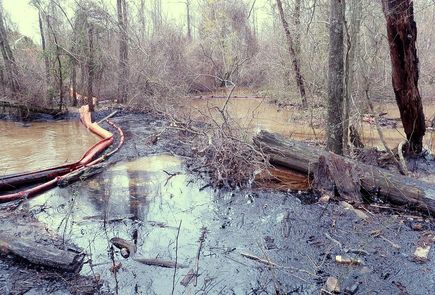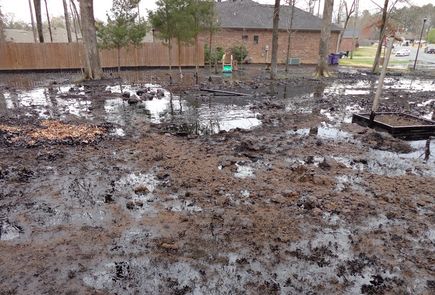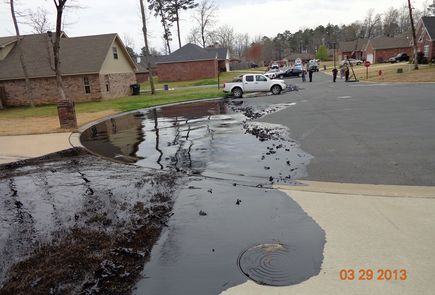
ExxonMobil diluted bitumen spill in Mayflower, Arkansas by U.S. Environmental Protection Agency used under CC BY-SA 3.0
Since Washington state lawmakers convened in Olympia this January and took up legislation on oil transport, the nation has seen at least one major pipeline spill when an Exxon pipe leaked 40,000 gallons of crude into the Yellowstone River. It was the second time in just a few years that the pipeline had ruptured: it spilled 63,000 gallons into the river in 2011, for which regulators fined the oil giant $1 million.
The latest incident was a timely reminder of just how common—and just how serious—oil pipeline spills are. In fact, in the last five years, there have been two other serious oil pipeline spills that did meaningful damage to the environment and local communities. Those stories are warnings for communities near existing pipelines, many of which are slated for expansion.
Kalamazoo River, Michigan (July 25, 2010)
Just upstream from where Talmadge Creek enters the Kalamazoo River at Marshall, Michigan, “corrosion fatigue” opened a six-and-a-half foot long rupture in Enbridge Line 6B, a 30-inch diameter pipeline carrying diluted bitumen from the Alberta tar sands. The failure allowed 843,000 gallons to spill into the water. Once in the river, the constituent parts of the oil separated–the lighter “diluents” evaporated while the heavier bitumen sank—rendering most conventional spill clean-up techniques such as booming and skimming useless. Instead, cleanup crews had to resort to a time-consuming and expensive process of “poling”—essentially sticking a long pole into the river bottom to dislodge and measure the buildup of bitumen—and dredging.
In the aftermath of the spill, the Kalamazoo River became a case study in the challenges of cleaning up tar sands oil. When exposed to sunlight on land or the riverbank, the bitumen formed a dense, sticky substance—likened by some local residents to chewing gum—that was very difficult to remove from rock and sediments. Michigan state officials closed fishing, swimming, and boating on the river and forced 150 families from their homes for the duration of the cleanup, which is still ongoing. Volatile Organic Compounds (VOCs) found in the bitumen caused extremely foul odors and led to headaches, dizziness, nausea, and vomiting in local residents. The spill killed hundreds of birds and other animals, including many freshwater turtles, while locals took thousands more to wildlife rehabilitation centers.
The Kalamazoo River empties into Lake Michigan, which is the primary source of water for around 36 million people. So far, no oil has reached the lake, although the EPA will continue to monitor the situation.
Among the factors that likely contributed to the initial rupture were the pipeline’s age—more than 50 years old—along with the particular hazards of moving diluted tar sands oil. Diluted bitumen, or “dilbit” as it is known in the business, is the most viscous, sulfurous, and acidic form of oil produced today. Pipelines carrying it must operate at higher temperatures and under higher pressure—both of which have been linked to increased corrosion rates—than do pipelines carrying conventional oil.
All told, the cleanup effort will cost Enbridge $1.21 billion, of which around $40 million dollars are expected to be fines from the EPA and the US Department of Transportation, which regulates pipeline operators. Enbridge also spent another $2.63 billion to replace Line 6B with a wider and thicker steel pipeline.
US Environmental Protection Agency estimates that 180,000 gallons of bitumen remain in the river, of which 90 percent will likely persist even after Enbridge completes dredging about 540,000 cubic yards of contaminated sediment from the river bed.
Mayflower, Arkansas (March 29, 2013)
Exxon Mobil’s Pegasus Pipeline runs 858 miles from Illinois to Texas, carrying diluted bitumen from the tar sands in Alberta to refineries on the Gulf Coast. Along the way, the northern segment of the pipeline runs through Mayflower, Arkansas, a quiet commuter town with a population of just over two thousand about 25 miles north of Little Rock.
When the pipeline burst on March 29, 2013 it sent 210,000 gallons of diluted bitumen literally flooding into the town. As one elderly resident said to a 911 operator, “I’ve got a river of oil coming down the street at me.”
Around 25 families with oil on their property were evacuated, but many others remained in the neighborhood. Dozens of residents, including local elementary school students, experienced dizziness, nausea, and vomiting as long as 10 months after the initial spill. Many of them moved away as a result. Officials detected dangerous levels of chemicals like benzene, a well-known carcinogen, and hydrogen sulfide, a toxic and corrosive gas. Property values plummeted in the previously high-end Northwoods subdivision where the spill occurred. Dozens of birds and turtles were killed as the oil flowed through wetlands and into nearby Lake Conway.
In response to the spill, Exxon inundated the town the money, initially paying for hotel and hospital costs, and even footing the bill for a $15,000 school party. Yet many residents report that Exxon was unwilling to pay for ongoing hospital expenses.
The bulk of the cleanup remains ahead, but exactly what caused the problem in the first place is still unclear because Exxon has declared confidential fully 870,000 pages of its materials related to the maintenance and repair of the pipeline. We do know, however, that the pipeline was built in 1947 and reversed in 2006. (Prior to 2006, it carried crude from Texas oil fields north to Illinois.) According to the US Pipeline & Hazardous Materials Safety Administration, Exxon’s own tests “provided more than adequate information for the pipe to be considered susceptible to seam failure” prior to the flow reversal, but the company proceeded to pump highly corrosive dilbit through the line anyway.
By November 2013, officials were estimating the costs of the spill at $70.5 million, though the cleanup was not yet completed. Although federal regulators proposed a fine of just $2.6 million, Exxon is also facing a class action lawsuit brought by more than 60 residents of Mayflower, claiming the company failed to report the spill for nearly three hours after a major drop in pressure was detected.











Rus Higley
Although not an oil spill, Bellingham had a natural gas pipeline break and explosion back in the 90’s.